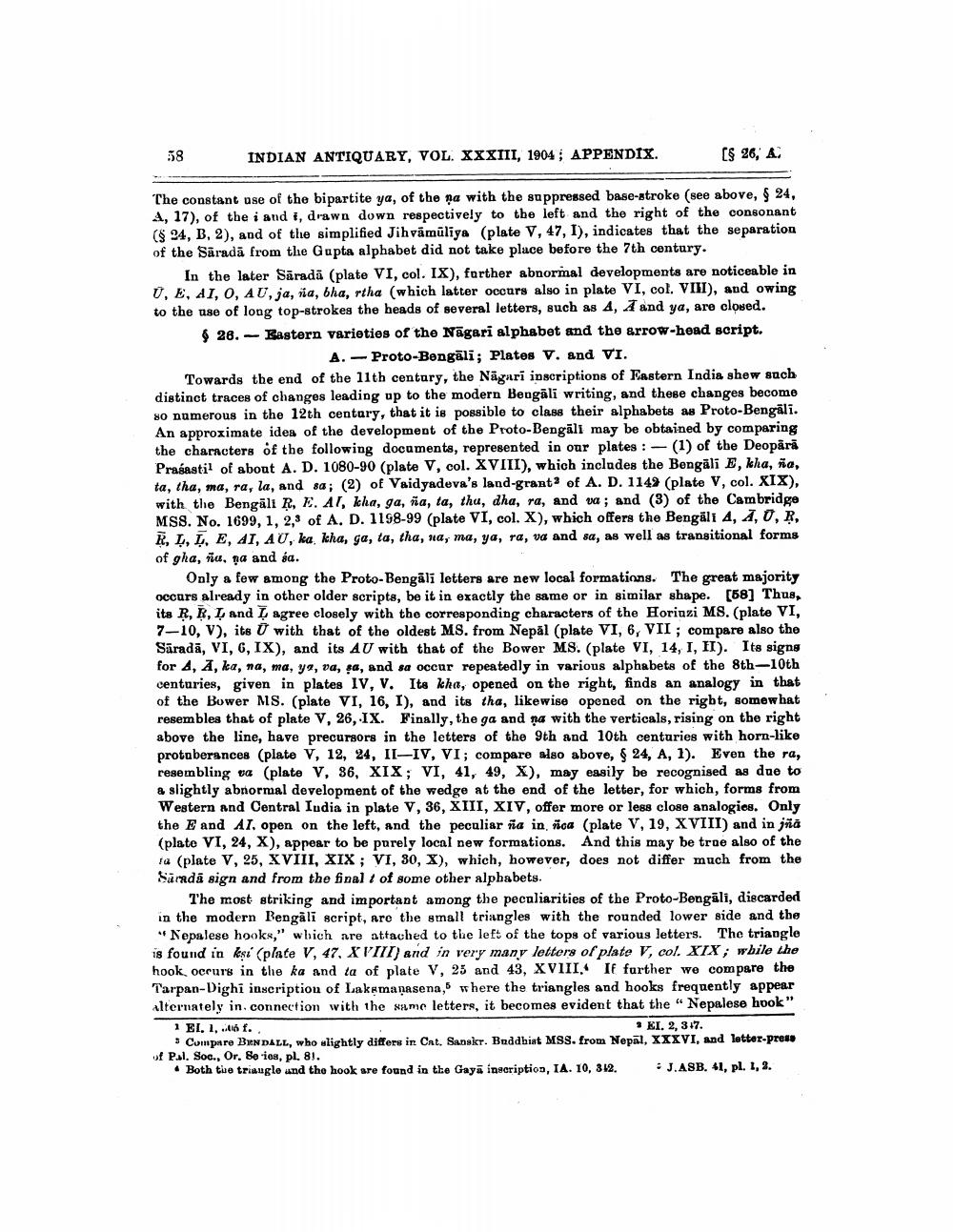________________
58
INDIAN ANTIQUARY, VOL. XXXIII, 1904 ; APPENDIX
($ 26, A.
The constant use of the bipartite ya, of the na with the suppressed base-stroke (see above, $ 24, A, 17), of the i and i, drawn down respectively to the left and the right of the consonant ($ 24, B, 2), and of the simplified Jihvamüliga (plate V, 47, I), indicates that the separation of the Sāradā from the Gupta alphabet did not take place before the 7th century.
In the later Särada (plate VI, col. IX), farther abnormal developments are noticeable in U, E, I, O, AU, ja, ria, bha, rtha (which latter occurs also in plate VI, col. VIII), and owing to the use of long top-strokes the heads of several letters, such as A, , and ya, are closed. 28. - Eastern varieties of the Nāgari alphabet and the arrow-head script.
A. - Proto-Bengāli; Plates v. and VI. Towards the end of the 11th century, the Nägari inscriptions of Eastern India shew such distinct traces of changes leading up to the modern Bengāli writing, and these changes become 80 numerous in the 12th century, that it is possible to class their alphabets as Proto-Bengāli. An approximate idea of the development of the Proto-Bengali may be obtained by comparing the characters of the following documents, represented in our plates : -(1) of the Deoparā Prasasti? of about A. D. 1080-90 (plate V, col. XVIII), which includes the Bengali E, kha, na, ta, tha, ma, ra, la, and sa; (2) of Vaidyadeva's land-grantof A. D. 1149 (plato V, col. XIX), with the Bengali R, E. AT, kha, ga, na, ta, thu, dha, ra, and va; and (3) of the Cambridge MSS. No. 1699, 1, 2,9 of A. D. 1198-99 (plate VI, col. X), which offers the Bengali A, Ā, 0, R, R, L, L, E, AI, AU, ka kha, ga, ta, tha, na, ma, ya, ra, va and sa, as well as transitional forms of gha, ria, na and sa.
Only a few among the Proto-Bengali letters are new local formations. The great majority occurs already in other older scripts, be it in exactly the same or in similar shape. [58] Thus, its R, R, L and agree closely with the corresponding characters of the Horiuzi MS. (plate VI, 7-10, V), its 0 with that of the oldest MS. from Nepal (plate VI, 6, VII ; compare also the Sāradā, VI, 6, IX), and its AU with that of the Bower MS. (plate VI, 14, I, II). Its signs for 4, A, ka, na, ma, yy, va, a, and sa occur repeatedly in various alphabets of the 8th-10th centuries, given in plates IV, V. Its kha, opened on the right, finds an analogy in that of the Bower MS. (plate VI, 16, I), and its tha, likewise opened on the right, somewhat resembles that of plate V, 26, IX. Finally, the ga and na with the verticals, rising on the right above the line, have precursors in the letters of the 9th and 10th centuries with horn-like protuberances (plate V, 12, 24, II-IV, VI; compare also above, $ 24, A, 1). Even the ra, resembling sa (plate V, 86, XIX; VI, 41, 49, X), may easily be recognised as due to & slightly abnormal development of the wedge at the end of the letter, for which, forms from Western and Central India in plate V, 36, XIII, XIV, offer more or less close analogies. Only the E and AT, open on the left, and the peculiar na in noa (plate V, 19, XVIII) and in jña (plate VI, 24, X), appear to be purely local new formations. And this may be troe also of the 1a (plate V, 25, XVIII, XIX; VI, 30, X), which, however, does not differ much from the Sända sign and from the final 1 of some other alphabets.
The most striking and important among the peculiarities of the Proto-Bengāli, discarded in the modern Bengali script, are the small triangles with the rounded lower side and the "Nepalese hookx," which are attached to the left of the tops of various letters. The triangle is found in kşi (plate V, 47, XVII) and in very many letters of plate V, col. XIX; while the hook, occurs in the ka and la of plate V, 25 and 43, XVIII. If further we compare the Tarpan-Dighi inscription of Laksmanasena, where the triangles and hooks frequently appear alternately in connection with the same letters, it becomes evident that the “ Nepalese hook" 1 EI, 1, 461.
• EI, 2, 317. Compare BIN DALL, who slightly differs in Cat. Sansir. Buddhist MSS. from Nepal, XXXVI, and letter-press of Psl. Soc., Or. Beries, pl. 81.
Both the triangle and the hook are found in the Gayā inscription, IA. 10, 312. • J.ASB. 41, pl. 1, 2.




